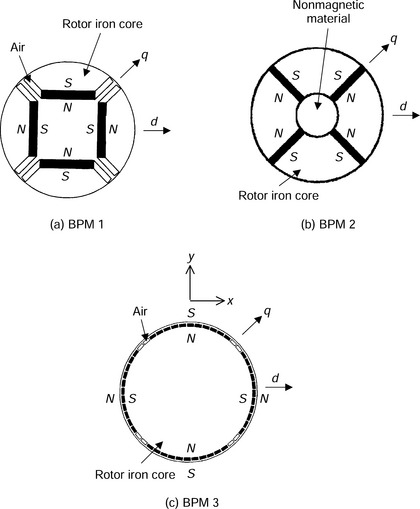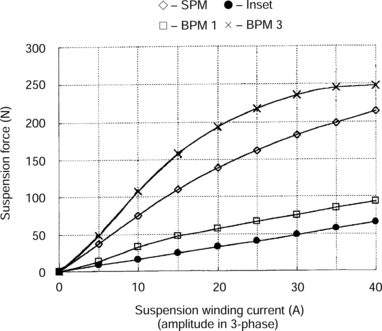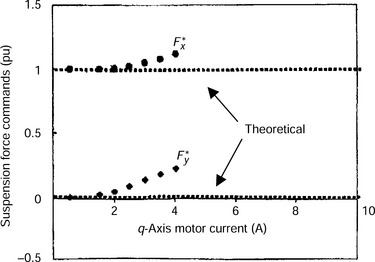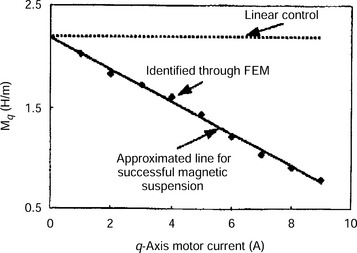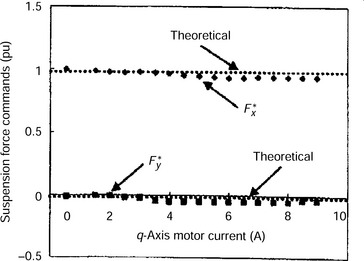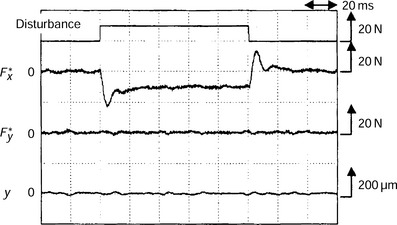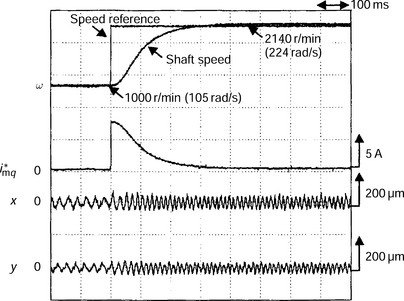Buried permanent magnet bearingless motors
Recently, buried permanent magnet (BPM) motors, often referred to as interior permanent magnet (IPM) motors, have become more commonplace. By employing a field-weakening control, adjustable speed operation can be realized over a wide speed range. In addition, a reluctance torque is generated which increases the motor efficiency. In this chapter, the BPM bearingless motor is introduced. The linear position control strategy employed in cylindrical and inset permanent magnet types of motor is not applicable because partial magnetic saturation occurs in the BPM motor so that the suspension force parameters λ′m, M′q and M′d are influenced by the operating currents. Therefore a successful position control strategy is introduced to solve this problem with off-line and on-line identification methods of parameter variations. The rotor structure and features are described. One of the advantages of this machine is that enhanced radial force can be obtained.
11.1 BPM rotor structures
Figure 11.1(a-c) shows the BPM rotor structures. The advantages of the BPM rotors are as follows:
1. The airgap length can be small compared with those in the other types of permanent magnet machines, resulting in an increase in the suspension force for unity suspension winding MMF.
2. The leakage flux goes around the permanent magnets in the rotor core, helping to prevent the irreversible demagnetization of the permanent magnets.
3. Since the permanent magnets are buried in the rotor core, they are protected against centrifugal force at high speed operation.
The structures BPM 1 and BPM 2, shown in Figure 11.1(a,b), are typical interior permanent magnet and spoke types of rotor [1]. The q-axis flux paths are sufficient to increase the saliency ratio. However, these types of rotor are not very suitable for a bearingless motor arrangement. Since the suspension forces are generated by the superimposition of the permanent magnet field and the suspension flux, and the suspension flux goes through the thick permanent magnets and the nonmagnetic material, the suspension forces for a unity suspension winding MMF are small. On the other hand, the rotor structure BPM 3 in Figure 11.1(c) has thin permanent magnets buried just below the rotor surface, which improves radial suspension force generation because of the low permanent magnet magnetic reluctance [2–4]. Therefore, this type of rotor is suitable for a BPM bearingless motor; and the suspension force, the permanent magnet demagnetization and the control strategy for this machine are introduced in this chapter.
11.2 Suspension force for unity current and permanent magnet demagnetization
The BPM 3 rotor shown in Figure 11.1(c) has a ratio of suspension force per unity suspension winding current which is higher than the other types of permanent magnet bearingless motors described in previous chapters. This is due to the small airgap length and the thin permanent magnets. In this section, the suspension force per unity current is compared in order to emphasize that the BPM 3 rotor structure is suitable in radial force generation. The ability to withstand irreversible demagnetization is also described.
11.3 Rotor position control strategy
11.3.1 Influence of suspension force parameter variations
The BPM bearingless motor is a salient-pole motor so that, using the control system shown in Figure 7.17, the rotor radial position can be, in principle, stably regulated. However, the suspension force becomes saturated due to partial magnetic saturation caused by the q-axis motor flux since the airgap length is smaller than the SPM and inset types of machine. Hence the suspension force parameters λ′m, M′q and M′d all have load variation. If one assumes that these parameters are constant then the magnetic suspension cannot be stable. Therefore the identification of the parameter variations and the controller integration of these variables are key issues for successful suspension.
11.3.2 Successful suspension with nonlinear magnetic characteristics
In order to regulate the rotor position accurately, it is important to consider the magnetic saturation caused by the q-axis motor current. The suspension winding currents can only be successfully controlled by considering the parameter variations. Hence it is necessary to express the suspension force parameters as functions of the motor winding currents, and in this section, therefore, an identification method for the suspension force parameters is introduced and an example of suspension force decoupling is described [3,4].
References
[1] Ohishi, T., Okada, Y., Miyamoto, S., “Levitation Control of IPM Type Rotating Motor”. Proceedings of the Fifth International Symposium on Magnetic Bearings, 1996:327–332.
[2] Ooshima, M., Miyazawa, S., Shima, Y., Chiba, A., Nakamura, F., Fukao, T., “Increase in Radial Forces of a Bearingless Motor with Buried Permanent Magnet-Type Rotor”. The 4th International Conference on Movic Proceedings, Vol. 3, 1998:1077–1082.
[3] Fujie, N., Yoshimatsu, R., Chiba, A., Ooshima, M., Rahman, M.A., Fukao, T., “A Decoupling Control Method of Buried Permanent Magnet Bearingless Motors Considering Magnetic Saturation”. Proceedings of IPEC-Tokyo 2000, Vol. 1, 2000:395–400.
[4] Fujie, N., Yoshimatsu, R., Chiba, A., Ooshima, M., Fukao, T., “Influence of Magnetic Saturation on Armature Reaction Flux in Buried Permanent Magnet Type Bearingless Motors”. IEE Japan, The Papers of Technical Meeting on Linear Drives LD-99–153, 1999:33–38.(in Japanese)

